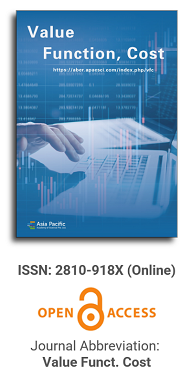
Asia Pacific Academy of Science Pte. Ltd. (APACSCI) specializes in international journal publishing. APACSCI adopts the open access publishing model and provides an important communication bridge for academic groups whose interest fields include engineering, technology, medicine, computer, mathematics, agriculture and forestry, and environment.
Study on the impact of PPP project payment formula on investment income
Vol 1, Issue 1, 2021
Download PDF
Abstract
Nowadays, with the increasingly fierce competition in the PPP market, the bidding quotation and investment returns are gradually declining. This paper systematically analyzes the current transaction structure and payment formulas commonly used in PPP projects, such as the Ministry of Finance formula method, average capital method as well average capital plus interest methods, and variant forms such as price-tax separation and equity-debt separation methods. By comparison, the advantages and disadvantages of different payment modes are displayed as well as matters needing attention. The Ministry of Finance formula method usually offers little operating subsidy in the early period and more subsidy in the later period, which is difficult for the companies to repay the capital and interest in the early period. Due to influence of the discount rate with reference to the local government bond yields during the same period, the investment returns are generally not promising and is not commonly used in actual operation. The average capital plus interest method maintains a stable level of operating subsidies every year, and owns a good capability to repay the capital and interest, thus having a relatively fair investment return. Therefore, it is the most commonly used method at present. In terms of the equal capital method, the operating subsidy is usually huge in the early period and less in the later operation period, which will increase the financial burden of the local governments, so it is rarely recognized by the local government in the actual operation. At the same time, this article analyzes the impact of different methods of repaying the capital and interest on the project investment returns. As average capital plus interest repayment can fully take the advantage of the low-cost debt to refinance, the project investment return is also higher than the average capital method in the same project.
Keywords
References
- China Public Private Partnerships Center (CPPPC). National PPP management database. Report of Oct 2019 [EB/OL]. (2019-11-28)[2019-12-05]. https://mp.weixin.qq.com/s/No2uvXfB1C9xJir_D0G6WQ.
- Liu T, Wang S, Sheng H, et al. International empirical study on selecting capital structure of PPP projects (in Chinese). Construction Economy 2014;11: 11–14.
- Xin L. Research on taxation of PP project payment mechanism (in Chinese). Taxation and Economy 2017; 2: 85–88.
- Fan Z. Discussion on the financial feasibility of availability payment mechanism of PPP project (in Chinese). China Journal of Commerce 2017; 34: 128–129.
- Zhen J, Hou M. Factors influencing government payment mechanism of public welfare PPP projects (in Chinese). Journal of Civil Engineering and Management 2018; 6: 149–156.
- Li M, Xing Y, Liao Y. Comparative study on payment mechanism of urban rail transit PPP modes (in Chinese). Urban Rapid Rail Transit 2016; 29(5): 26–31.
- Xie B. Discussion on tax treatment of PPP project under different payment mechanism. Finance & Accounting for Communications 2019; 379(2): 42–47.
- Liu J. Research on government payment of PPP project based on system dynamics [MSc thesis]. Tsinghua University; 2016.
- Zuo Y. An exploration on factors affecting government payment in PPP projects. Shanxi Architecture 2018; 44(35): 224–225.
- Wang B. Payment mechanism of overseas highway PPP project. International Project Contracting & Labour Service 2019; 415(2): 68–70.
- Nie X. Research on payment mechanism of PPP modes [MSc thesis]. University of Electronic Science and Technology of China; 2018.
- Zhou G. Basic ideas for further improving the PPP mode of highway infrastructure. China Highway 2018; 523(15): 63–66.
- Ministry of Finance. Notification of Guidelines for Demonstrating the Financial Sustainability of Public-Private Partnership Projects issued by Ministry of Finance of People’s Republic of China [EB/OL]. Apr 3 2015 [2019-12-10]. http://www.gov .cn/gongbao/content/2015/content_2897169.htm.
- Liang Y, Shen T. Discussion on risk allocation scheme of government-paid PPP project of highway engineering. Shandong Jiaotong Keji 2019; 1: 118–120.
- China Public Private Partnerships Center (CPPPC). Selected PPP cases abroad. Beijing: China Commerce and Trade Press; 2014.
Supporting Agencies
Copyright (c) 2021 Fei Wang, Fahong Zhang, Qinghua Yue, Kaiyu Cheng, Jialiang Yu, Jian Liu
License URL: https://creativecommons.org/licenses/by/4.0/

This site is licensed under a Creative Commons Attribution 4.0 International License (CC BY 4.0).
Zhibiao Gao
Nankai University, China

